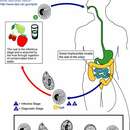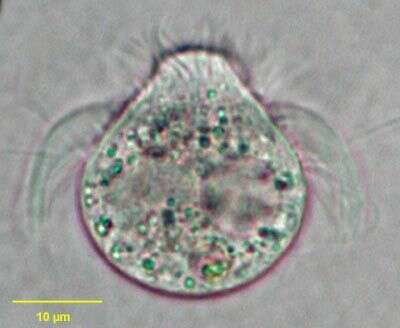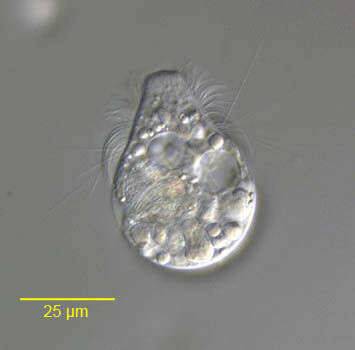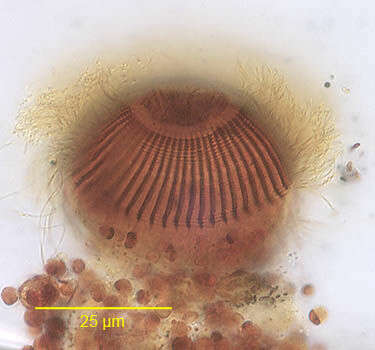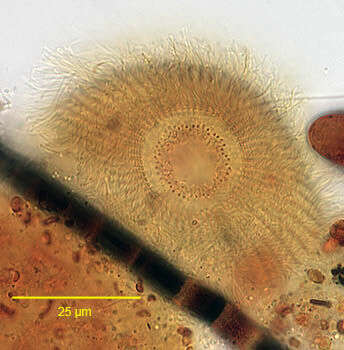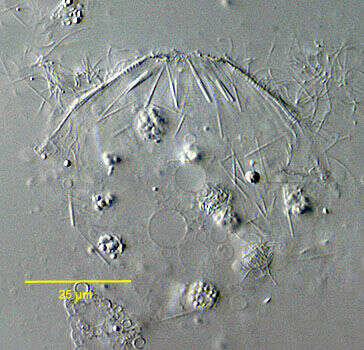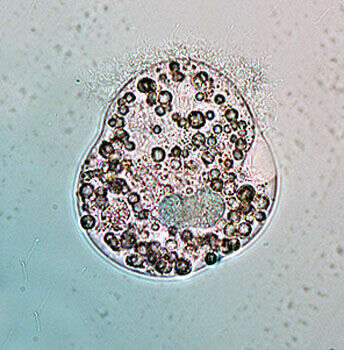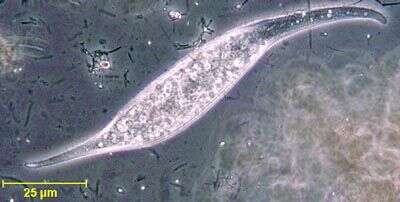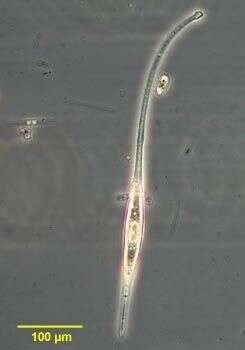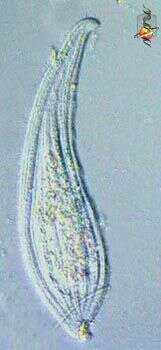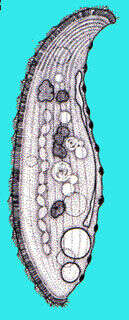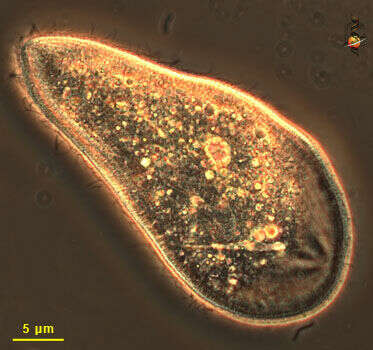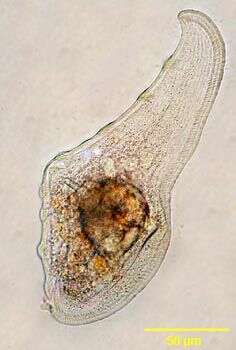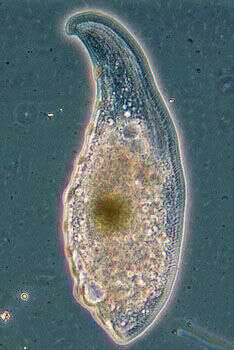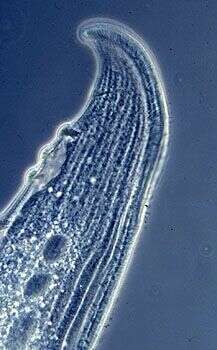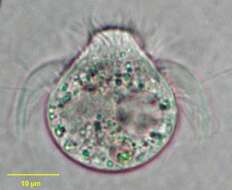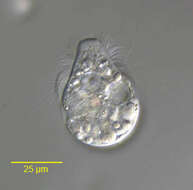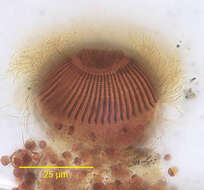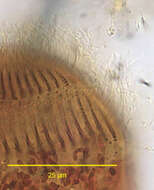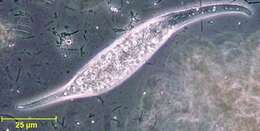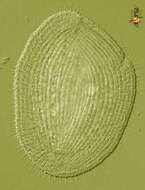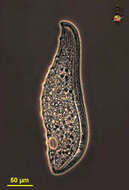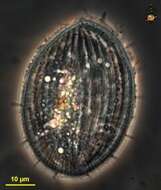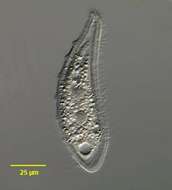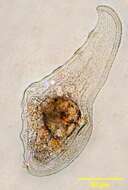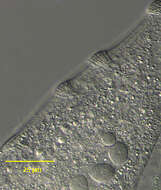-
Posterior apical view of the haptorid ciliate,Askenasia volvox (Eichwald,1852) Kahl, 1930. The cell is spherical posteriorly and the anterior is a truncate cone.The cytostome is at the anterior apex.The cytostome is surrounded by an undulating line of granules (seen only in silver impregnated specimens).Somatic cilia are arranged in three (anterior,middle and posterior)girdles.The posterior girdle consists of long stiff bristles (seen here).The anterior cilia are directed forward and the middle girdle cilia are longer,curving backwards in a "sickle" configuration.These cilia produce the saltatory locomotion typical of this genus (they are seen well in this image).The posterior of the cell is unciliated.The central macronucleus is C-shaped. There is a single subequatorial contractile vacuole (seen here to viewer's left). From a freshwater pond near Boise, Idaho.DIC.
-
Lateral view of the haptorid ciliate,Askenasia volvox (Eichwald,1852) Kahl, 1930. The cell is spherical posteriorly and the anterior is a truncate cone.The cytostome is at the anterior apex.The cytostome is surrounded by an undulating line of granules (seen only in silver impregnated specimens).Somatic cilia are arranged in three (anterior,middle and posterior)girdles.The posterior girdle consists of long stiff bristles (seen here).The anterior cilia are directed forward and the middle girdle cilia are longer,curving backwards in a "sickle" configuration.These cilia produce the saltatory locomotion typical of this genus (they are seen well in this image).The posterior of the cell is unciliated.The central macronucleus is C-shaped. There is a single subequatorial contractile vacuole (seen here to viewer's right). From a freshwater pond near Boise, Idaho.Brightfield with closed condenser.
-
Lateral view of the haptorid ciliate,Askenasia volvox (Eichwald,1852) Kahl, 1930. The cell is spherical posteriorly and the anterior is a truncate cone.The cytostome is at the anterior apex.The cytostome is surrounded by an undulating line of granules (seen only in silver impregnated specimens).Somatic cilia are arranged in three (anterior,middle and posterior)girdles.The posterior girdle consists of long stiff bristles (seen here).The anterior cilia are directed forward and the middle girdle cilia are longer,curving backwards in a "sickle" configuration.These cilia produce the saltatory locomotion typical of this genus (they are seen well in this image).The posterior of the cell is unciliated.The central macronucleus is C-shaped. There is a single subequatorial contractile vacuole (seen here to viewer's right). From a freshwater pond near Boise, Idaho.DIC.
-
Anterolateral view of the infraciliature of the haptorid ciliate,Askenasia volvox (Eichwald,1852) Kahl, 1930. The cell is spherical posteriorly and the anterior is a truncate cone.The cytostome is at the anterior apex.The cytostome is surrounded by an undulating line of granules (seen only in silver impregnated specimens).Somatic kineties are arranged in three (anterior,middle and posterior)girdles seen in this image.The anterior cilia are directed forward and the middle girdle cilia are longer,curving backwards in a "sickle" configuration.These cilia produce the saltatory locomotion typical of this genus.The posterior girdle consists of long stiff bristles.The posterior of the cell is unciliated.The central macronucleus is C-shaped. There is a single subequatorial contractile vacuole.Stained by the silver carbonate technique (see Foissner, W. Europ. J. Protistol., 27:313-330;1991). From a freshwater pond near Boise, Idaho.Brightfield.
-

Anterolateral view of the infraciliature of the haptorid ciliate,Askenasia volvox (Eichwald,1852) Kahl, 1930. The cell is spherical posteriorly and the anterior is a truncate cone.The cytostome is at the anterior apex.The cytostome is surrounded by an undulating line of granules (seen only in silver impregnated specimens).Somatic kineties are arranged in three (anterior,middle and posterior)girdles seen in this image.The anterior cilia are directed forward and the middle girdle cilia are longer,curving backwards in a "sickle" configuration.These cilia produce the saltatory locomotion typical of this genus.The middle ciliary girdle kineties have a zig-zag configuration (best seen here to the viewer's right).The posterior girdle consists of long stiff bristles (the three kinetids of these bristles are seen immediately posterior to the middle ciliary girdle kineties).The posterior of the cell is unciliated.Stained by the silver carbonate technique (see Foissner, W. Europ. J. Protistol., 27:313-330;1991). From a freshwater pond near Boise, Idaho.Brightfield.
-
Anterolateral view of the infraciliature of the haptorid ciliate,Askenasia volvox (Eichwald,1852) Kahl, 1930. The cell is spherical posteriorly and the anterior is a truncate cone.The cytostome is at the anterior apex.The cytostome is surrounded by an undulating line of granules (seen here).Somatic kineties are arranged in three (anterior,middle and posterior)girdles seen in this image.The anterior cilia are directed forward and the middle girdle cilia are longer,curving backwards in a "sickle" configuration.These cilia produce the saltatory locomotion typical of this genus.The middle ciliary girdle kineties have a zig-zag configuration seen here.The posterior girdle consists of long stiff bristles.The posterior of the cell is unciliated.Stained by the silver carbonate technique (see Foissner, W. Europ. J. Protistol., 27:313-330;1991). From a freshwater pond near Boise, Idaho.Brightfield.
-
Extrusomes of the haptorid ciliate,Askenasia volvox (Eichwald,1852) Kahl, 1930. The cell is disrupted by coverslip pressue.The cytostome is at the anterior apex.The needle-loke extrusomes (some in bundles)are seen here scattered through the cytoplasm.In the living organism they are in a longitudinal bundle posterior to the anterior apical oral dome. From a freshwater pond near Boise, Idaho.DIC.
-
Macronucleus (stained green in this preparation)of the haptorid ciliate,Askenasia volvox (Eichwald,1852) Kahl, 1930. The cell is spherical posteriorly and the anterior is a truncate cone.The short C-shaped macronucleus is in the posterior cell perpendicular to the long axis.Stained by the methyl green-pyronin technique (see Foissner, W. Europ. J. Protistol., 27:313-330;1991). From a freshwater pond near Boise, Idaho.Brightfield.
-
Portrait of Amphileptus, a widely distributed haptorid ciliate with posterior drawn out to a tapered point and elongate anterior neck region. Prominent refractile trichites are clustered at the anterior end of the neck region. Right side longitudinal kineties converge on one another anteriorly and posteriorly in a diamond shaped pattern unlike the parallel kineties of the similar genus Litonotus. The mouth is slit-like and difficult to see, located on the convex aspect of the neck region. Two spherical macronuclei. Multiple contractile vacuoles along dorsal and ventral margins. Some species attach to and prey on stalked peritrich ciliates. From freshwater pond near Boise, Idaho. Phase contrast.
-
Portrait of Amphileptus filum (Gruber,1884) Gruber, 1888, a markedly elongated haptorid ciliate. Distinguished from the very similar Litonotus Cygnus by the cluster of brightly refractile trichites at the anterior tip of the neck region and the anteriorly and posteriorly converging kineties. From freshwater pond near Boise, Idaho. Phase contrast.
-
Loxophyllum (locks-o-file-um) is one of several genera of flat gliding predatory ciliates. It glides along the substrate, exploring detritus with the anterior convex margin - which is where the mouth is located. There are rod-shaped extrusomes lying just under the cell membrane and in some species in prominences along the margins of the cell - not well developed in this cell. The extrusomes can be discharged to kill potential prey - usually other ciliates. Surface view of slightly squashed cell shows the surface folds where the rows of cilia (kineties) are located. Differential interference contrast.
-
Loxophyllum (locks-o-file-um) is one of several genera of flat gliding predatory ciliates. It glides along the substrate, exploring detritus with the anterior convex margin - which is where the mouth is located. There are rod-shaped extrusomes lying just under the cell membrane and in some species in prominences along the margins of the cell - not well developed in this cell. The extrusomes can be discharged to kill potential prey - usually other ciliates. Phase contrast.
-
Loxophyllum (locks-o-file-um) a predatory ciliate. It is flattened, and glides along the substrate, exploring detritus with the anterior convex margin - which is where the mouth is located. There are extrusomes just internal to the margin of the cell, and also in some species prominences along the margins of the cell - not well developed in this cell. The extrusomes can be discharged to kill potential prey - usually other ciliates. Common. Differential interference contrast.
-
-
Loxophyllum, a leaf-like predatory ciliate. The mouth lies along the convex side of the body. The convex side has a number of warts and each wart contains many extrusomes. Feeds on detritus and other protists. Phase contrast micrograph.
-
Loxophyllum. Cell observed in sandy and muddy marine sediments in the vicinity of Broome, Western Australia in September 2003. This image was taken using phase contrast optics. Â Â This work was supported by the Australian Biological Resources Study.
-
A somewhat contracted cell, extrusomes are evident as thin rods underlying the surface of the cell. Phase contrast microscopy.
-
Portrait of Loxophyllum helus (Stokes, 1884, Penard, 1922) a rhabdophorine ciliate. The body is elongate and laterally compressed. The left side is sparsely ciliated and slightly domed the flat right side is more densely ciliated. Very flexible. Prominent trichocyst warts occur at intervals along the dorsal edge (seen well here). A narrow flattened band traversed by trichocysts runs along the entire ventral edge. The slit-like oral aperture is located on the anterior ventral edge. There is one posterior contractile vacuole. The macronucleus is bipartite flanking a small micronucleus. Preys on rotifers and other ciliates. Collected from freshwater pond near Boise, Idaho in June 2003. DIC optics.
-
Portrait of Loxophyllum helus (Stokes, 1884, Penard, 1922) a rhabdophorine ciliate. The body is elongate and laterally compressed. The left side is sparsely ciliated and slightly domed the flat right side is more densely ciliated. Very flexible. Prominent trichocyst warts occur at intervals along the dorsal edge (seen well here). A narrow flattened band traversed by trichocysts runs along the entire ventral edge. The slit-like oral aperture is located on the anterior ventral edge. There is one posterior contractile vacuole. The macronucleus is bipartite flanking a small micronucleus. Preys on rotifers and other ciliates. Collected from freshwater pond near Boise, Idaho in June 2003. DIC optics.
-
Portrait of Loxophyllyum, large pleurostomatid ciliate, which is highly laterally, compressed. Glides with ribbon-like movement over substrate. Oral region is slit-like and oriented to the right in this image. Wart-like aggregates of extrusomes are seen at intervals along the dorsal (left) surface. Macronucleus is multinodal in this species. Many species. This species, from standing fresh water near Boise, Idaho, has been preying on rotifers. Oblique illumination.
-
Portrait of the pleurostomatid ciliate, Loxophyllyum meleagris (Mueller,1773) Dujardin, 1841. Glides with ribbon-like movement over substrate. Oral region is slit-like and oriented to the right in this image. Wart-like aggregates of extrusomes are seen at intervals along the dorsal (left) surface. Macronucleus is multinodal in this species. From standing temporary fresh water puddlenear Boise, Idaho. Phase contrast illumination.
-
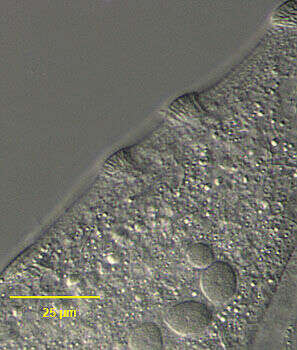
Detail view (dorsal surface) of the large pleurostomatid ciliate, Loxophyllum meleagris (Mueller,1773) Dujardin, 1841. The strongly laterally compressed cell is scimitar-shaped in outline. . The cell is slightly contractile and highly flexible. The rounded anterior end is curved dorsally. The posterior is bluntly tapered. The right side is more densely ciliated than the left. Somatic kineties are longitudinal. The dorsal edge bears characteristic nodular protrusions called extrusome warts (seen well here). The slit-like cytostome is located along the anteroventral edge. There is one posterior contractile vacuole which has a long collecting canal extending anteriorly along the dorsal edge of the cell. The macronucleus (part of which is seen well here) is moniliform. There are multiple inconspicuous micronuclei (not seen here). L.meleagris swims slowly, gliding gracefully over the substrate. L.meleagris feeds on other ciliates and even metazoans such as rotifers. Differentiated from the similar L. helus by its much larger size. Collected from a freshwater agricultural irrigation ditch near McCall, Idaho 9/21/03. DIC.
-
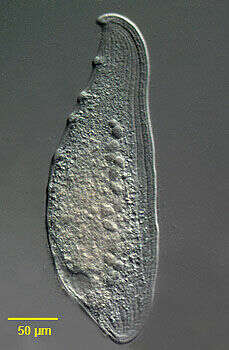
Portrait (right side) of the large pleurostomatid ciliate, Loxophyllum meleagris (Mueller,1773) Dujardin, 1841. The strongly laterally compressed cell is scimitar-shaped in outline. . The cell is slightly contractile and highly flexible. The rounded anterior end is curved dorsally. The posterior is bluntly tapered. The right side is more densely ciliated than the left. Somatic kineties are longitudinal. The dorsal edge bears characteristic nodular protrusions called extrusome warts. The slit-like cytostome is located along the anteroventral edge. There is one posterior contractile vacuole which has a long collecting canal extending anteriorly along the dorsal edge of the cell. The macronucleus is moniliform. There are multiple inconspicuous micronuclei (not seen here). L.meleagris swims slowly, gliding gracefully over the substrate. L.meleagris feeds on other ciliates and even metazoans such as rotifers. Differentiated from the similar L. helus by its much larger size. Collected from a freshwater agricultural irrigation ditch near McCall, Idaho 9/21/03. DIC.
-
This image of the anterior end shows the curved oral region with faintly visible extrusomes that are used to capture protists as food. The surface is folded along the lines of the kineties. The contractile vacuole, upper left, has a long feeding canal, and the macronucleus is in the form of a series of linked beads. Phase contrast.

